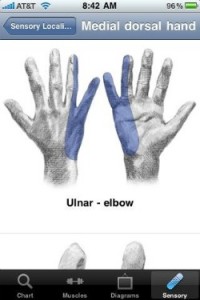New educational tool developed by U-M doctor works on iPhones, other personal devices
With a new application developed by a U-M neurologist, better understanding of the anatomy of the peripheral nervous system can be found right on your iPhone.
Nerve Whiz is a free application for medical professionals interested in learning the complex anatomy of nerve roots, plexuses, and peripheral nerves. It can work on Apple personal devices such as iPhones, iPads and iPods, and will soon be available for Android devices.
The application goes beyond simple nerve charts to help medical professionals interpret clinical examinations. Users select which muscles are weak or point to where the patient has sensory loss and the application provides a differential diagnosis, complete with relevant pictures and diagrams.
“Before you can figure out what is causing neurologic symptoms, you have to determine what part of the nervous system isn’t functioning normally. Neurologists call this ‘localizing the lesion,’” says Zachary London, M.D., assistant professor of neurology, director of the University of Michigan neurology residency program and inventor and developer of Nerve Whiz.
“Nerve Whiz helps you localize by taking the information from your physical examination of a patient and synthesizing a list of possible anatomic regions which could be disrupted,” explains London. “If there is more than one possibility, Nerve Whiz lets you know which other muscles you need to examine to hone in on the answer.”
The application is popular among physicians, medical students, physical therapists, occupational therapists, and anatomists in the United States and abroad. As of May this year, over 33,000 different users had downloaded Nerve Whiz.
“Anybody with an iPhone or iPad can use this. Just go to the iPhone App Store, search for ‘nerve whiz’ and download it right to your smart phone,” says London.
Nerve Whiz was financed by the Jerry Isler Neuromuscular Fund. Jerry Isler was diagnosed with a painful neuromuscular disease affecting his legs when he came to seek treatment from London.
Isler was very happy with the care he received at U-M and, with his wife, established the Jerry Isler Neuromuscular Fund in late 2009 to support U-M research and education related to neuromuscular disorders.
“This philanthropy has been the most satisfying thing we’ve done,” says Jerry Isler. “And it was totally unexpected.”
“Nerve Whiz takes the mystery out of the peripheral nervous system. Now anyone can learn to think more like a neurologist,” says London.

